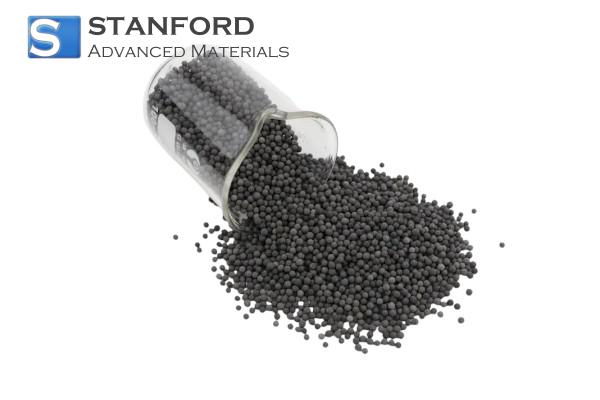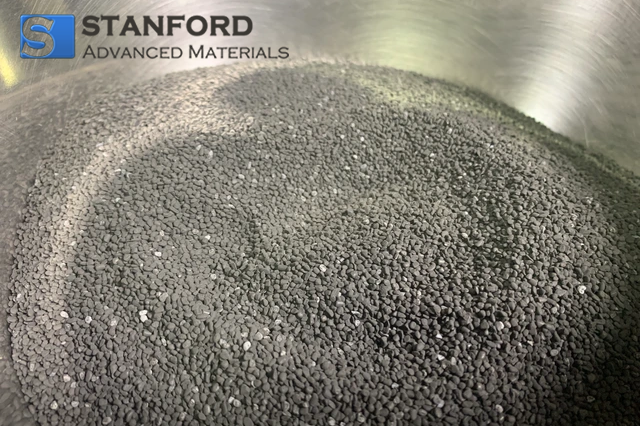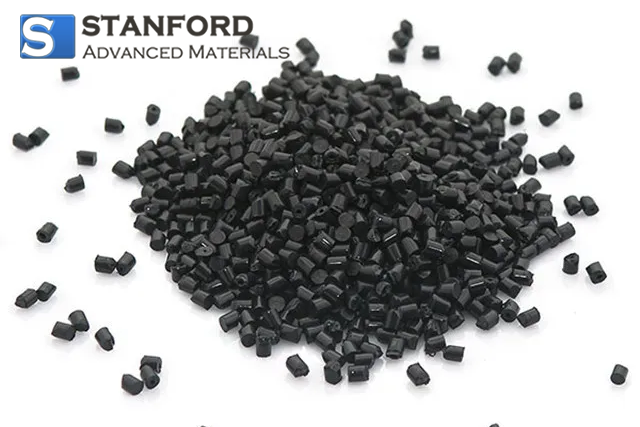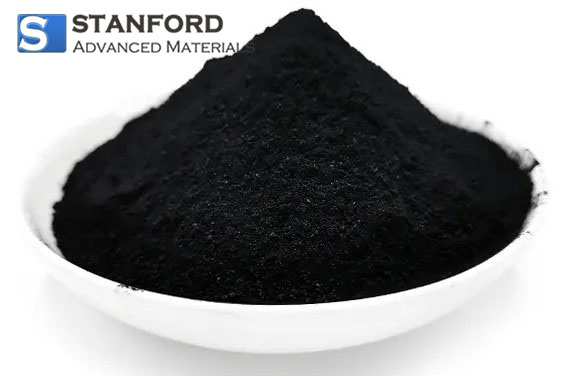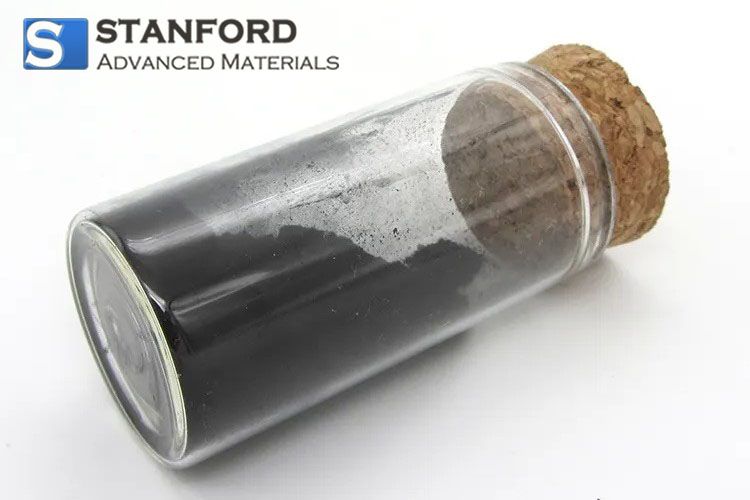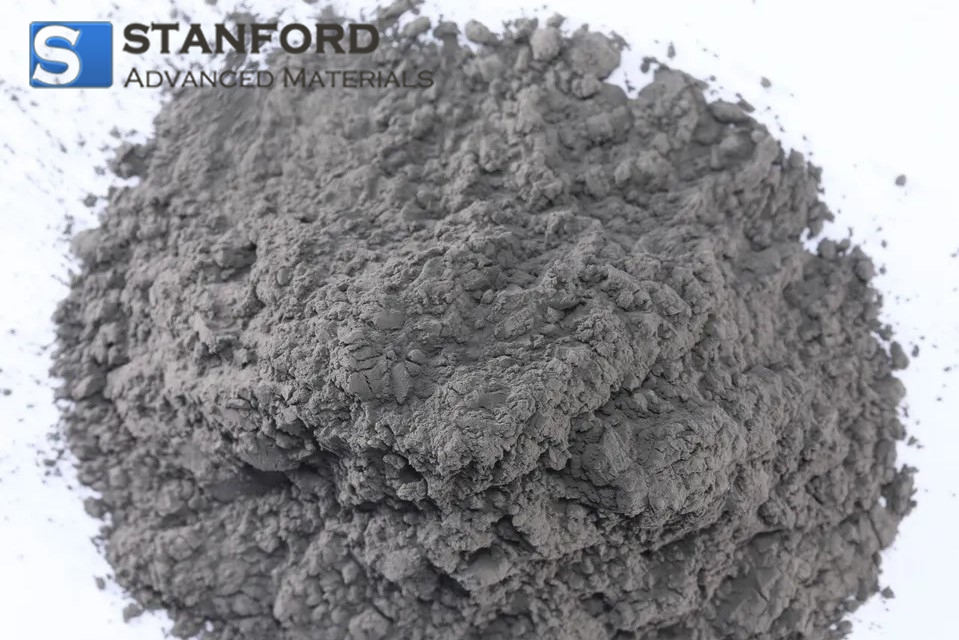SECTION 1. IDENTIFICATION
Product Name: Platinum on Silica
CAS #: 7440-06-4
Relevant identified uses of the substance: Scientific research and development
Supplier details:
Stanford Advanced Materials
E-mail: sales@samaterials.com
Tel: (949) 407-8904
Address: 23661 Birtcher Dr., Lake Forest, CA 92630 U.S.A.
SECTION 2. HAZARDS IDENTIFICATION
Classification of the substance or mixture
GHS Classification in accordance with 29 CFR 1910 (OSHA HCS)
Flammable solids(Category 1), H228
For the full text of the H-Statements mentioned in this Section, see Section 16.
GHS Label elements, including precautionary statements
Pictogram
Signal word
Danger
Hazard statement(s)
H228
Flammable solid.
Precautionary statement(s)
P210
Keep away from heat/sparks/open flames/hot surfaces. -No smoking.
P240
Ground/bond container and receiving equipment.
P241Use explosion-proof electrical/ ventilating/ lighting/ equipment.
P280
Wear protective gloves/ eye protection/ face protection.
P370 + P378
In case of fire: Use dry sand, dry chemical or alcohol-resistant foam for extinction.
Hazards not otherwise classified (HNOC) or not covered by GHS-none
SECTION 3. COMPOSITION/INFORMATION ON INGREDIENTS
Substances
Formula: Pt
Molecular weight: 195.08 g/mol
CAS-No.: 7440-06-4
EC-No.: 231-116-1
Component: Platinum
Classification: Flam. Sol.1; H228
Concentration: <=100%
For the full text of the H-Statements mentioned in this Section, see Section 16.
SECTION 4. FIRST AID MEASURES
Description of first aid measures
General advice
Consult a physician. Show this safety data sheet to the doctor in attendance.
Move out of dangerous area.
If inhaled
If breathed in, move person into fresh air. If not breathing, give artificial respiration. Consult a
physician.
In case of skin contact
Wash off with soap and plenty of water. Consult a physician.
In case of eye contact
Flush eyes with water as a precaution.
If swallowed
Do NOT induce vomiting. Never give anything by mouth to an unconscious person. Rinse mouth with
water. Consult a physician.
Most important symptoms and effects, both acute and delayed
The most important known symptoms and effects are described in the labelling (see section 2) and/or
in section 11
Indication of any immediate medical attention and special treatment needed
No data available
SECTION 5. FIREFIGHTING MEASURES
Extinguishing media
Suitable extinguishing media
Use water spray, alcohol-resistant foam, dry chemical or carbon dioxide.
Special hazards arising from the substance or mixture
No data available
Advice for firefighters
Wear self-contained breathing apparatus for firefighting if necessary.Further information
Use water spray to cool unopened containers.
SECTION 6. ACCIDENTAL RELEASE MEASURES
Personal precautions, protective equipment and emergency procedures
Avoid dust formation. Avoid breathing vapors, mist or gas. Ensure adequate ventilation. Remove all
sources of ignition. Evacuate personnel to safe areas.
For personal protection see section 8.
Environmental precautions
Prevent further leakage or spillage if safe to do so. Do not let product enter drains.
Methods and materials for containment and cleaning up
Sweep up and shovel. Contain spillage, and then collect with an electrically protected vacuum cleaner
or by wet-brushing and place in container for disposal according to local regulations (see section 13).
Keep in suitable, closed containers for disposal. Contain spillage, pick up with an electrically protected
vacuum cleaner or by wet-brushing and transfer to a container for disposal according to local
regulations (see section 13).
SECTION 7. HANDLING AND STORAGE
Precautions for safe handling
Avoid formation of dust and aerosols.
Further processing of solid materials may result in the formation of combustible dusts. The potential for
combustible dust formation should be taken into consideration before additional processing occurs.
Provide appropriate exhaust ventilation at places where dust is formed.Keep away from sources of
ignition -No smoking. Take measures to prevent the build up of electrostatic charge.
For precautions see section 2.
Conditions for safe storage, including any incompatibilities
Keep container tightly closed in a dry and well-ventilated place.
Keep in a dry place.
Storage class (TRGS 510): Flammable solid hazardous materials
Specific end use(s)
Apart from the uses mentioned in section 1 no other specific uses are stipulated
SECTION 8. EXPOSURE CONTROLS/PERSONAL PROTECTION
Exposure controls
Appropriate engineering controls
Handle in accordance with good industrial hygiene and safety practice. Wash hands before breaks
and at the end of workday.
Personal protective equipment
Eye/face protection
Safety glasses with side-shields conforming to EN166 Use equipment for eye protection tested and
approved under appropriate government standards such as NIOSH (US) or EN 166(EU).
Skin protection
Handle with gloves. Gloves must be inspected prior to use. Use proper glove removal technique
(without touching glove's outer surface) to avoid skin contact with this product. Dispose of
contaminated gloves after use in accordance with applicable laws and good laboratory practices.
Wash and dry hands.
If used in solution, or mixed with other substances, and under conditions which differ from EN 374,contact the supplier of the CE approved gloves. This recommendation is advisory only and must be
evaluated by an industrial hygienist and safety officer familiar with the specific situation of anticipated
use by our customers. It should not be construed as offering an approval for any specific use scenario.
Body Protection
Flame retardant antistatic protective clothing., The type of protective equipment must be selected
according to the concentration and amount of the dangerous substance at the specific workplace.
Respiratory protection
Where risk assessment shows air-purifying respirators are appropriate use a full-face particle
respirator type N100 (US) or type P3 (EN 143) respirator cartridges as a backup to engineering
controls. If the respirator is the sole means of protection, use a full-face supplied air respirator. Use
respirators and components tested and approved under appropriate government standards such as
NIOSH (US) or CEN (EU).
Control of environmental exposure
Prevent further leakage or spillage if safe to do so. Do not let product enter drains.
SECTION 9. PHYSICAL AND CHEMICAL PROPERTIES
Information on basic physical and chemical properties
Appearance
Form: powder
Odor
No data available
Odor Threshold
No data available
pH
No data available
Melting point/freezing point
Melting point/range: 1,772 °C (3,222 °F)-lit.
Initial boiling point and boiling range: 3,827 °C (6,921 °F)-lit.
Flash point
N/A
Evaporation rate
No data available
Flammability (solid, gas)
The substance or mixture is a flammable solid with the category 1.
Upper/lower flammability or explosive limits
No data available
Vapor pressure
No data available
Vapor density
No data available
Relative density
21.45 g/mL
Water solubility
No data available
Partition coefficient: n-octanol/water
No data available
Auto-ignition temperature
No data available
Decomposition temperature
No data available
Viscosity
No data availableExplosive properties
No data available
Oxidizing properties
No data available
Other safety information
No data available
SECTION 10. STABILITY AND REACTIVITY
Reactivity
No data available
Chemical stability
Stable under recommended storage conditions.
Possibility of hazardous reactions
No data available
Conditions to avoid
Heat, flames and sparks.
Incompatible materials
Strong oxidizing agents, Alcohols
Hazardous decomposition products
Hazardous decomposition products
-Carbon monoxide, Carbon dioxide (CO2), Sulphur oxides
Other decomposition products
-No data available
In the event of fire: see section 5
SECTION 11. TOXICOLOGICAL INFORMATION
Information on toxicological effects
Acute toxicity
No data available
Inhalation: No data available
Dermal: No data available
Skin corrosion/irritation
No data available
Serious eye damage/eye irritation
No data available
Respiratory or skin sensitisation
No data available
Germ cell mutagenicity
No data available
Carcinogenicity
Carcinogenicity- Rat-Implant
Tumorigenic:Equivocal tumorigenic agent by RTECS criteria. Tumorigenic:Tumors at site or
application.
Carcinogenicity-Mouse-Implant
Tumorigenic:Equivocal tumorigenic agent by RTECS criteria. Tumorigenic:Tumors at site or
application.
IARC:
No component of this product present at levels greater than or equal to 0.1% is identified as
probable, possible or confirmed human carcinogen by IARC.ACGIH:
No component of this product present at levels greater than or equal to 0.1% is identified as a
carcinogen or potential carcinogen by ACGIH.
NTP:
No component of this product present at levels greater than or equal to 0.1% is identified as a
known or anticipated carcinogen by NTP.
OSHA:
No component of this product present at levels greater than or equal to 0.1% is identified as a
carcinogen or potential carcinogen by OSHA.
Reproductive toxicity
No data available
Specific target organ toxicity -single exposure
No data available
Specific target organ toxicity -repeated exposure
No data available
Aspiration hazard
No data available
Additional Information
RTECS: TP2160000
Stomach-Irregularities-Based on Human Evidence
Stomach-Irregularities-Based on Human Evidence
SECTION 12. ECOLOGICAL INFORMATION
Toxicity
No data available
Persistence and degradability:
No data available
Bioaccumulative potential:
No data available
Mobility in soil:
No data available
Results of PBT and vPvB assessment:
PBT/vPvB assessment not available as chemical safety assessment not required/not conducted
Other adverse effects
No data available
SECTION 13. DISPOSAL CONSIDERATIONS
Waste treatment methods
Product
Burn in a chemical incinerator equipped with an afterburner and scrubber but exert extra care in
igniting as this material is highly flammable.
Offer surplus and non-recyclable solutions to a licensed disposal company.
Contaminated packaging
Dispose of as unused product.
SECTION 14. TRANSPORT INFORMATION
DOT (US)UN number: 3089
Class: 4.1
Packing group: II
Proper shipping name: Metal powders, flammable, n.o.s.
Reportable Quantity(RQ):
Poison Inhalation Hazard: No
IMDG
UN number: 3089
Class: 4.1
Packing group: II
EMS-No: F-G, S-G
Proper shipping name: METAL POWDER, FLAMMABLE, N.O.S.
IATA
UN number: 3089
Class: 4.1
Packing group: II
Proper shipping name: Metal powder, flammable, n.o.s.
SECTION 15. REGULATORY INFORMATION
SARA 302 Components
No chemicals in this material are subject to the reporting requirements of SARA Title III, Section 302.
SARA 313 Components
This material does not contain any chemical components with known CAS numbers that exceed the
threshold (De Minimis) reporting levels established by SARA Title III, Section 313.
SARA 311/312 Hazards
Fire Hazard, Chronic Health Hazard
Massachusetts Right To Know Components
Platinum
CAS-No. 7440-06-4
Revision Date
1993-04-24
Pennsylvania Right To Know Components
Platinum
CAS-No. 7440-06-4
Revision Date
1993-04-24
New Jersey Right To Know Components
Platinum
CAS-No. 7440-06-4
Revision Date
1993-04-24
California Prop. 65 Components
This product does not contain any chemicals known to State of California to cause cancer, birth
defects, or any other reproductive harm.
SECTION 2. HAZARDS IDENTIFICATION
Classification of the substance or mixture in accordance with 29 CFR 1910 (OSHA HCS)
The substance is not classified according
to the Globally Harmonized System (GHS).Hazards not otherwise classified
No data available
GHS label elements
N/A
Hazard pictograms
N/A
Signal word
N/A
Hazard statements
N/A
WHMIS classification
Not controlled
Classification system
HMIS ratings (scale 0-4)
(Hazardous Materials Identification System)
Health (acute effects) = 1
Flammability = 0
Physical Hazard = 0
Other hazards
Results of PBT and vPvB assessment
PBT:
N/A
vPvB:
N/A
SECTION 3. COMPOSITION/INFORMATION ON INGREDIENTS
Substances
CAS No. / Substance Name:
Platinum, 4% on silica
SECTION 4. FIRST AID MEASURES
Description of first aid measures
If inhaled:
Supply patient with fresh air. If not breathing, provide artificial respiration. Keep patient warm.
Seek immediate medical advice.
In case of skin contact:
Immediately wash with soap and water; rinse thoroughly.
Seek immediate medical advice.
In case of eye contact:
Rinse opened eye for several minutes under running water. Consult a physician.
If swallowed:
Seek medical treatment.
Information for doctor
Most important symptoms and effects, both acute and delayed
No data available
Indication of any immediate medical attention and special treatment needed
No data available
SECTION 5. FIREFIGHTING MEASURES
Extinguishing media
Suitable extinguishing agents
Product is not flammable. Use fire-fighting measures that suit the surrounding fire.
Special hazards arising from the substance or mixture
If this product is involved in a fire, the following can be released:
Metal oxide fume
Silicon oxide
Advice for firefighters
Protective equipment:
Wear self-contained respirator.
Wear fully protective impervious suit.
SECTION 6. ACCIDENTAL RELEASE MEASURES
Personal precautions, protective equipment and emergency procedures
Use personal protective equipment. Keep unprotected persons away.
Ensure adequate ventilation
Environmental precautions:
Do not allow material to be released to the
environment without official permits.
Methods and materials for containment and cleanup:
Pick up mechanically.
Prevention of secondary hazards:
No special measures required.
Reference to other sections
See Section 7 for information on safe handling
See Section 8 for information
on personal protection equipment.
SECTION 7. HANDLING AND STORAGE
Handling
Precautions for safe handling
Keep container tightly sealed.
Store in cool, dry place in tightly closed containers.
Information about protection against explosions and fires:
The product is not flammable
Conditions for safe storage, including any incompatibilities
Requirements to be met by storerooms and receptacles:
No special requirements.
Information about storage in one common storage facility:
No data available
Further information about storage conditions:
Keep container tightly sealed.
Store in cool, dry conditions in well-sealed containers.
Specific end use(s)
No data available
SECTION 8. EXPOSURE CONTROLS/PERSONAL PROTECTION
Properly operating chemical fume hood designed for hazardous chemicals and
having an average face velocity of at least 100 feet per minute.
Control parameters
Components with limit values that require monitoring at the workplace:
Silica, amorphous-diatomaceous earth
mg/m3
ACGIH TLV 10 (inhalable particulate)
3 (respirable particulate)
Germany TWA
4 (inhalable fraction of the aerosol)
Ireland TWA 1.5
United Kingdom TWA 1.2 (respirable dust)
USA PEL 20 mppcf
Silica, amorphous
mg/m3
Ireland TWA 3 (respirable); 6 (total inhalable)
United Kingdom TWA 2.4 (respirable); 6 (total inhalable)
Silica, amorphous-fused
mg/m3
ACGIH TLV 0.1 (respirable particulate)
Finland TWA 5
Germany TWA 0.3 (respirable fraction of the aerosol)
Ireland TWA 0.1 (respirable)
United Kingdom TWA 0.3 (respirable dust)
Silica, amorphous-fume
mg/m3
ACGIH TLV 2 (respirable particulate)
Germany TWA 0.3 (respirable fraction of the aerosol)
Silica, amorphous-precipitated and gel
mg/m3
ACGIH TLV 10 (inhalable particulate)
Germany TWA
4 (inhalable fraction of the aerosol)
USA PEL 20 mppcf
Silica, crystalline-quartz
mg/m3
ACGIH TLV 0.1
Austria MAK 0.15
Belgium TWA 0.1
Finland TWA 0.2
France VME 10/(X+2)
Germany MAK 0.15
Korea TLV 0.1
Netherlands MAC-TGG 0.075
Norway TWA 0.3 (total dust)
0.1 (resp. dust)
Russia 14-STEL
Sweden NGV 0.1 (resp. dust)
Switzerland MAK-W 0.15
United Kingdom TWA 0.3 (respirable)
USA PEL 10/(% resp. SiO2+2)30/(% SiO2+2) (total sust)
Silica, crystalline-tridymite and cristobalite mg/m3
ACGIH TLV 0.05 (respirable particulate)
Belgium TWA 0.05
Denmark TWA 0.05
Finland TWA 0.1
France TWA 10
Germany TWA 0.15 (respirable fraction of the aerosol)
Ireland TWA 0.4 (respirable)
Netherlands TWA 0.075 (respirable)
Sweden TWA 0.05
Switzerland TWA 0.15
USA PEL 0.5 (value calculated for quartz-respirable dust)
Silica, crystalline-tripoli
mg/m3
ACGIH TLV 0.1 (of contained respirable quartz)
Belgium TWA 0.1
Germany TWA 0.15 (respirable fraction of the aerosol)
Ireland TWA 0.4 (respirable)
USA PEL See quartz
Platinum metal and soluble salts (as Pt)
mg/m3
ACGIH TLV 1 (metal); 0.002 (soluble salts)
Austria MAK 1 (metal); 0.002 (soluble salts)
Belgium TWA 1 (metal); 0.002 (soluble salts)
Denmark TWA 0.002 (soluble salts)
Finland TWA 1 (metal); 0.002 (soluble salts)
France VME 1 (metal)
Germany MAK 0.002 (soluble salts)-Ceiling
Hungary TWA 0.001; 0.002-STEL (soluble salts)
Korea TLV 1 (metal); 0.002 (soluble salts)
Netherlands MAC-TTG 1 (metal); 0.002 (soluble salts)
Norway TWA 0.002
Switzerland MAK-W 0.002
United Kingdom TWA 5 (metal); 0.002 (soluble salts)
USA PEL 0.002
Additional information:
No data
Exposure controls
Personal protective equipment
Follow typical protective and hygienic practices for handling chemicals.
Keep away from foodstuffs, beverages and feed.
Remove all soiled and contaminated clothing immediately.
Wash hands before breaks and at the end of work.
Maintain an ergonomically appropriate working environment.
Breathing equipment:
Use suitable respirator when high concentrations are present.
Protection of hands:
Impervious gloves
Inspect gloves prior to use.
The selection of suitable gloves not only
depends on the material, but also on quality. Quality will vary from manufacturer to manufacturer.
Penetration time of glove material (in minutes)
No data available
Eye protection:Safety glasses
Body protection:
Protective work clothing.
SECTION 9. PHYSICAL AND CHEMICAL PROPERTIES
Information on basic physical and chemical properties
Appearance:
Form:
Powder
Color:
Grey
Odor:
No data available
Odor threshold:
No data available.
pH:
N/A
Melting point/Melting range:
No data available
Boiling point/Boiling range:
No data available
Sublimation temperature / start:
No data available
Flammability (solid, gas)
No data available.
Ignition temperature:
No data available
Decomposition temperature:
No data available
Autoignition:
No data available.
Danger of explosion:
Product does not present
an explosion hazard.
Explosion limits:
Lower:
No data available
Upper:
No data available
Vapor pressure:
N/A
Density:
No data available
Relative density
No data available.
Vapor density
N/A
Evaporation rate
N/A
Solubility in / Miscibility with
Water:
InsolublePartition coefficient (n-octanol/water):
No data available.
Viscosity:
Dynamic:
N/A
Kinematic:
N/A
Other information
No data available
SECTION 10. STABILITY AND REACTIVITY
Reactivity
No data available
Chemical stability
Stable under recommended storage conditions.
Thermal decomposition / conditions to be avoided:
Decomposition will not occur if used and
stored according to specifications.
Possibility of hazardous reactions
No dangerous reactions known
Conditions to avoid
No data available
Incompatible materials:
No data available
Hazardous decomposition products:
Metal oxide fume
Silicon oxide
SECTION 11. TOXICOLOGICAL INFORMATION
Information on toxicological effects
Acute toxicity:
No effects known.
LD/LC50 values that are relevant for classification:
No data
Skin irritation or corrosion:
May cause irritation
Eye irritation or corrosion:
May cause irritation
Sensitization:
Platinum salts, especially ionic platinum halogeno complexes, may cause severe allergic reactions.
Germ cell mutagenicity:
No effects known.
Carcinogenicity:
IARC-3: Not classifiable as
to carcinogenicity to humans.
Reproductive toxicity:
No effects known.
Specific target organ system toxicity - repeated exposure:
No effects known.Specific target organ system toxicity - single exposure:
No effects known.
Aspiration hazard:
No effects known.
Subacute to chronic toxicity:
Exposure to platinum containing dusts or fumes may cause irritation, sensitization reactions and
asthma. Effects include sneezing, coughing, tightness in the chest, dyspnea and wheezing. Cyanosis
is possible. Chronic exposure may result in pulmonary fibrosis.
Subacute to chronic toxicity:
No effects known.
Subacute to chronic toxicity:
Prolonged inhalation of silica may cause silicosis, the formation of adhesions in the lungs progressing
to the formation of a continuous mass of fibrous tissue. If the
disease continues, death may occur. Tuberculosis is often found in people with silicosis. Some forms
of silica are more fibrogenic than others. Some forms of crystalline silica have shown carcinogenic,
tumorigenic and neoplastic effects in laboratory animals. Amorphous silica is less
harmful by inhalation than crystallineforms. Amorphous silica may, however, contain small amounts of
crystalline silica.
Additional toxicological information:
To the best of our knowledge the acute and chronic toxicity of this substance is not fully known.
SECTION 12. ECOLOGICAL INFORMATION
Toxicity
Aquatic toxicity:
No data available
Persistence and degradability
No data available
Bioaccumulative potential
No data available
Mobility in soil
No data available
Additional ecological information:
Do not allow material to be released to the
environment without official permits.
Avoid transfer into the environment.
Results of PBT and vPvB assessment
PBT:
N/A
vPvB:
N/A
Other adverse effects
No data available
SECTION 13. DISPOSAL CONSIDERATIONS
Waste treatment methods
Recommendation
Consult official regulations to ensure proper disposal.
Uncleaned packagings:
Recommendation:Disposal must be made according to official regulations.
SECTION 14. TRANSPORT INFORMATION
Not a hazardous material for transportation.
UN-Number
DOT, IMDG, IATA
None
UN proper shipping name
DOT, IMDG, IATA
None
Transport hazard class(es)
DOT, ADR, IMDG, IATA
Class
None
Packing group
DOT, IMDG, IATA
None
Environmental hazards:
N/A
Special precautions for user
N/A
Transport in bulk according to Annex II of MARPOL73/78 and the IBC Code
N/A
Transport/Additional information:
Not dangerous according to
the above specifications.
DOT
Marine Pollutant (DOT):
No
SECTION 15. REGULATORY INFORMATION
Safety, health and environmental regulations/legislation specific for the substance or mixture
GHS label elements
N/A
Hazard pictograms
N/A
Signal word
N/A
Hazard statements
N/A
National regulations
All components of this product are listed in the U.S. Environmental Protection Agency Toxic
Substances Control Act Chemical substance Inventory.
All components of this product are listed on the Canadian Domestic Substances List (DSL).
SARA Section 313 (specific toxic chemical listings)
Substance is not listed.
California Proposition 65
Prop 65 - Chemicals known to cause cancer
Substance is not listed.Prop 65 - Developmental toxicity
Substance is not listed.
Prop 65 - Developmental toxicity, female
Substance is not listed.
Prop 65 - Developmental toxicity, male
Substance is not listed.
Information about limitation of use:
For use only by technically qualified individuals.
Other regulations, limitations and prohibitive regulations
Substance of Very High Concern (SVHC) according to the REACH Regulations (EC) No.1907/2006.
Substance is not listed.
The conditions of restrictions according to Article 67 and Annex XVII of the Regulation (EC) No
1907/2006 (REACH) for the manufacturing, placing on the market and use must be observed.
Substance is not listed.
Annex XIV of the REACH Regulations (requiring Authorisation for use)
Substance is not listed.
Chemical safety assessment:
A Chemical Safety Assessment has not been carried out.
SECTION 16. OTHER INFORMATION
Safety Data Sheet according to Regulation (EC) No. 1907/2006 (REACH). The above information is
believed to be correct but does not purport to be all inclusive and shall be used only as a guide. The
information in this document is based on the present state of our knowledge and is applicable to the
product with regard to appropriate safety precautions. It does not represent any guarantee of the
properties of the product.

